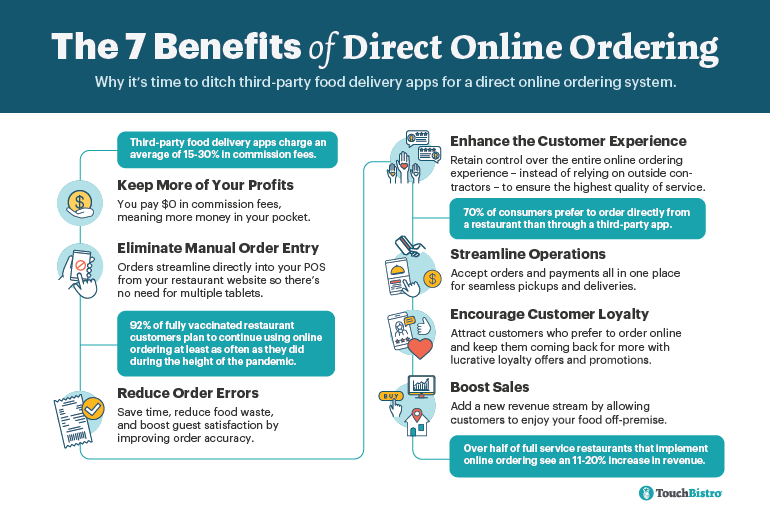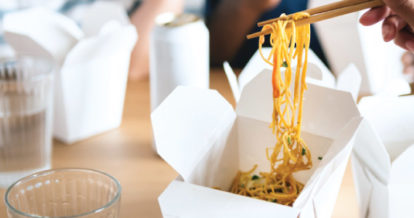The on-demand economy sparked by Uber, Netflix, and Amazon has certainly spread to the restaurant industry with the meteoric rise of food delivery services like DoorDash and Uber Eats. In fact, today the food delivery global market has expanded to reach a total worth of $150 billion, more than tripling in worth since 2017.
Nowadays, the speed and convenience that food delivery apps offer is simply the standard for consumers. Consumers want convenience in all aspects of their lives, including food, and restaurants can do that by signing up with third-party apps, or creating their own takeout and delivery channel.
In short, all restaurants are different and serve very different customers, so there’s no one-size-fits-all answer when it comes to offering a food delivery service.
Here, we’re laying out all the factors for you, so you can decide whether or not becoming a restaurant with delivery service is the right decision for your business.
In this food delivery guide, you’ll learn:
- The latest food delivery trends
- The pros and cons of offering food delivery service
- What to consider before making the decision, including location, venue type, and customers
- How to decide whether to take delivery in house or use a third-party service
- What you’ll need to implement a restaurant delivery service, including logistics and tools
By the end of this article, you’ll be able to make an informed decision about the best food delivery service for your restaurant.
Food Delivery Trends
According to the New Yorker, food delivery orders made up 7% of restaurant sales in the U.S. in 2016. Over the next few years, we saw the number of diners ordering delivery and takeout steadily increase. But it was the pandemic that pushed this trend into overdrive. In fact, the pandemic more than doubled food-delivery apps’ business.
And while food delivery may have fallen from its pandemic peek, it’s still a very viable channel for restaurants. Our 2023 State of Restaurants Report showed that restaurants are currently doing about 25% of their business through online ordering, which is a sizable amount of sales.
Now of course, not every restaurant online ordering system is the same. While some restaurants are relying on third-party apps for both takeout and delivery (high volume and higher fees), others are opting for an in-house or direct online ordering system (potentially lower volume but low or no fees), and some restaurants are using a mix of both. If you’re not doing any of the above, you’re missing out on an essential revenue stream. Your first step is to look into your options and figure out what works best for your business.

The Rise of Ghost Restaurants
Food delivery has already made a major impact on the restaurant industry. In fact, it’s even inspired a whole new category of restaurant: ghost restaurants.
Ghost restaurants are restaurants that only offer food via delivery. Unlike traditional restaurants, they don’t have brick-and-mortar locations where you can dine-in or sometimes even pick up. They typically run out of commercial kitchens, so the focus is on food preparation and order fulfillment, rather than an experience.
Essentially, ghost restaurants help diners get their favorite dishes quickly and easily, while lowering operational costs for restaurant owners in the following areas:
- Rent: They need less space and therefore have lower rent.
- Labor: They don’t require front-of-house staff so they save on labor.
- Space & Decor: They don’t offer a dine-in experience so they save on furniture, place settings, and decor.
Enabled by advances in technology and the rise in food delivery apps, ghost kitchens are likely here to stay. Ghost kitchens not only give restaurants a more sustainable business model, but they also help operators meet the high demand for takeout and delivery from consumers and vary their offerings.
That being said, you don’t have to run a ghost restaurant to profit from the benefits of food delivery.
The Pros and Cons of Implementing a Food Delivery Service
So is offering food delivery service at your restaurant worth it?
Let’s dive into the pros and cons of restaurant delivery services.
5 Advantages of Food Delivery Service
These are some compelling benefits of food delivery services.
- Increased check sizes. Restaurants see a 20% increase in check sizes from online and delivery orders versus dine-in orders.
- More business opportunities. Sometimes customers want your food paired with the comfort of their own home. By offering delivery, you’re able to serve a wider range of customers.
- Less overhead. If delivery becomes the bulk of your business or if you shift to a ghost kitchen model, you could look at downsizing your space to save on rent or front-of-house staff to save on labor.
- Exposure to new customers. Delivery can help you reach new customers outside of the regulars, locals, and other customers from surrounding neighborhoods. Plus, it’s even more important in urban locations, where potential customers may not have access to a car. Third-party apps can help amplify this reach, since they double as marketing platforms. When you sign up for Uber Eats, DoorDash, or Ritual, you’re putting your restaurant in front of their collective millions of customers. You’ll get your menu in front of diners who are outside normal walking distance – hello to new regulars!
Cons of Offering Food Delivery Service at Your Restaurant
What are the disadvantages of food delivery services?
- Less control. Whether you’re using an in-house or third-party fleet, you have less control over a customer’s experience with delivery. Customers could have a bad impression of your restaurant due to traffic or road conditions or a wrong turn – delays that have nothing to do with you or your food. If food arrives cold or poorly presented after the trip, it could negatively impact a customer’s opinion of your restaurant. You also have fewer opportunities to turn a bad experience around because you aren’t there when customers eat your food.
- More work to implement. If you choose to fulfill deliveries in-house, you have to deal with the hassle of looking for new staff and vehicles while creating a process for a successful service.
- Smaller profit margins. If you’re using your own delivery fleet, you have to pay for the drivers, their insurance, their gas, etc. All these costs eat into your profit margin. If you’re using third-party delivery services, again there are costs. Even the best food delivery app companies will take deep cuts of each meal delivered, which means you have to have a high volume of orders to see any real profit.
- More points of contact and more room for error. When working with a food delivery service, there will be more points of contact between the order being prepared and the food ending up in the hands of the customer, which could leave more room for errors. Whether you have in-house drivers or you use a third-party fleet, you won’t be there to ensure the driver is maintaining the quality you’ve set for your restaurant.
3 Things to Consider Before Deciding Whether or Not to Offer Delivery Service
Food delivery isn’t a one-size-fits-all solution for restaurants. Consider your venue, location, and customers before determining whether or not to offer delivery.
1) Venue Type
A few years ago, delivery was best for restaurants where the food stood apart from the experience. If a big part of your offering was the venue ambiance or chef plating, you risked losing this important aspect of your brand with the delivery experience.
However, even fine dining restaurants are getting in on delivery now – it’s just about reframing the experience.
Many upscale restaurants have started offering takeout options that let diners bring that fine dining experience home. Maison Selby, for example, is a Toronto-based French bistro and cocktail bar that lets guests place orders online for pickup, or order delivery by Uber Eats. Guests can even pair their to-go meal with a bottle of wine or a bottled cocktail if they so choose.
You can even get takeout from Michelin-star restaurants across the country now – from Toronto to New York to Los Angeles – some of the biggest names in the restaurant industry have created at-home fine dining options.
Delivery can also be tricky for traditional fast food venues. Fast food was meant to be consumed quickly after being made, so quality could diminish by the time the consumer gets the delivery. No one likes soggy fries!
To combat these challenges, some fast food restaurants are reducing their menus in order to provide more efficient service and get orders out the door – and into the hands of waiting delivery customers – faster.
2) Customers
Before implementing a delivery service at your restaurant, talk to your current customers to see if they would use it. Would they visit your restaurant more or less often if delivery was an option? Would they dine-in less and order delivery more?
Also think about the new customers you could reach by offering food delivery. TouchBistro’s 2023 Diner Trends Report found that Gen Z diners are big fans of takeout, with 45% of Gen Z diners in Canada and the U.S. saying they order takeout weekly or more often. However, other generations are not far behind, with 38% of Millennials ordering takeout with the same frequency.
Are Millennials or Gen Z part of your target demographic? What about families? If they aren’t now, should they be? You could open yourself up to new clientele by implementing delivery.
3) Location
Delivery is more popular in cities than in suburban or rural areas where people already have cars and can drive to pick up food. Opt for delivery where people seek convenience over an experience.

DIY vs. Outsourcing Your Restaurant’s Food Delivery Service
If you decide to deliver food to your customers, will you take on delivery yourself by hiring someone to perform the deliveries or will you outsource delivery to a third party service?
Here are some things to consider for both scenarios.
DIY Food Delivery Considerations
If you opt for in-house delivery, you’ll need to find and train a delivery driver. Look for someone who has prior delivery experience and a vehicle. Pay for the driver’s gas and contribute to the upkeep of their vehicle, because you wouldn’t be able to offer delivery without it. You’ll also have to check with your insurance and make sure you can properly insure your driver.
The delivery fee and business gained by offering delivery will help offset the cost of hiring a new person, but a lot of work goes into hiring and training the right person for the job.
There are also ways to outsource the delivery portion, but keep the online ordering in house through an integration like TouchBistro Online Ordering and DoorDash Drive. If the thought of managing your own fleet of drivers seems overwhelming, but you don’t want to fork over the high fees for third-party delivery apps, consider tapping into other networks that provide you with just the drivers.

Using a Third-Party Delivery Service
If you use a third-party for both ordering and delivery service, it’ll be less work for you, but you’ll have to share your profits with that platform.
The costs you’ll have to put towards your third-party delivery service include:
- Set-up: The set up fee costs between $0 to $400, and is a one time-cost to add your menu, find hardware and software for your restaurant, and get on the map.
- Transaction: With most apps, you can expect a per transaction fee, which is a percentage of each other. Depending on where you are, the percentage varies – busier areas typically have higher fees. Typically you’re looking at 10% to 40% of each transaction.
- Marketing: If you’re looking for how to market your restaurant delivery service, a third-party app can help you do just that. This can cost as little or as much as you’re willing to put into it. Most apps offer priority placement, promoted listings, and featured offerings – for a price. The prices range depending on which third-party app you use.
Keep in mind that customers may blame your restaurant if something goes wrong with delivery, even if it’s the delivery service’s fault.
This means you’ll want to have a system for responding in place before a customer complains. Do you have somebody dedicated to answering customer feedback? Prepare them with what to say if something goes wrong with a delivery order. It may be worth having an offer in place that encourages customers to come back, like 20% off their next order.
What You Need to Implement Food Delivery Service at Your Restaurant
If your restaurant doesn’t already offer delivery service, here are some of the top resources you’ll need to get you up to speed as fast as possible:
1. Staff
Food delivery requires staff. If you decide to handle deliveries in-house, you’ll need:
- A dedicated employee or two who can deliver orders to customers (if you’re doing delivery in-house)
- A front-of-house employee to oversee and process orders, coordinate with your drivers or third-party delivery folks, and update online menus when an item is 86’d
- Additional back-of-house staff to accommodate the extra order volume (cook and/or expeditor)
If you have some staff that are looking for a way to top up their hours, handling deliveries could be a great opportunity. If you do repurpose existing staff, just make sure you’re setting aside time for additional training.
2. Tech
A lot of restaurant technology goes into running a successful food delivery service.
Here’s exactly what you’ll need for the various stages of the order and delivery process.
- Receiving orders – You can let customers place delivery orders in three ways: over the phone, online (Google or your own website), and a third-party app. Whether you’re opting for one, two, or all three, we recommend getting a system that streamlines orders right into your POS, since mistakes in manually entered orders can cost you up to $4,000 each year.* TouchBistro offers direct online ordering you can place right on your website (or order.tbdine.com), as well as an integration that will pull in orders from the leading delivery platforms directly into your POS.
- Fulfilling orders – Another benefit of the above-mentioned integration and direct online ordering is that both options help cut down on clutter and help increase efficiency, so you get more orders out the door faster. Instead of one tablet for each delivery platform, you just have your POS that centralizes all the orders. Those orders appear automatically on your POS, so you can just hit accept.
- Delivering orders – If you decide to fulfill delivery in-house, you’ll need to equip your delivery driver with a vehicle, insulated bags to keep food warm during delivery, and a smartphone for communication and navigation. If you opt for third-party delivery services, they’ll take care of these logistics for you.
*based on TouchBistro’s estimate of a restaurant’s average annual online ordering revenue
3. Cost
These are some of the costs you can expect to face if you choose to implement an in-house food delivery service at your restaurant. If you choose to go with a third-party option, each provider offers unique rates.
- Labor – For in-house delivery, you’ll need to pay your drivers.
- Cost: Approximately $2,333 per month, according to Glassdoor
- Online ordering – Setting up a system to take online orderings on your website and streamline them right into your POS can cost anywhere from $50 to $140 per month, with some also charging per transaction fees (psst…with TouchBistro Online Ordering you pay no commission fees so you get to keep more of the profits).
- Cost: $50 to $140 per month
- Integration for third-party apps – If your POS doesn’t integrate with online ordering software, you’ll need to get one that does.
- Cost: Most POS online ordering integrations range from $30 to $100 per month
- Delivery packaging – You may already have takeout food packaging for doggy bags and pick up orders, but you’ll need to stock up when you begin offering delivery. You may also need to upgrade to containers that ensure that items don’t spill during delivery and food temperature stays even.
- Cost: Approximately $960 to $2,160 per year. (Delivery-focused restaurants spend approximately $0.63 to $1.45 on takeout packaging per order. Our range was calculated based on 50 delivery orders per day, but with increase takeout orders right now this number may be higher)
Food delivery is a long-term investment, which is why it’s important to do your research before deciding if it’s right for your business.
Deciding whether or not to become a restaurant with delivery service is a choice that you should make based on your business’ needs, resources, venue type, customer base, and location.
One thing is certain: If it wasn’t before, the food delivery trend is definitely here to stay now.
Free online ordering signs for your restaurant
Sign up for our free weekly TouchBistro Newsletter







